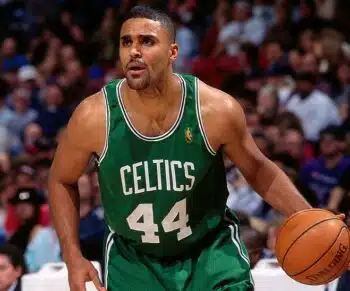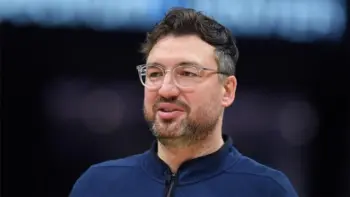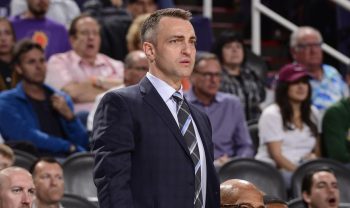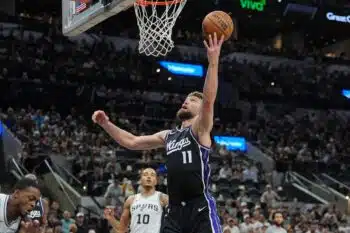NBA
NBA Finals 2025: 4 Takeaways from Game 1
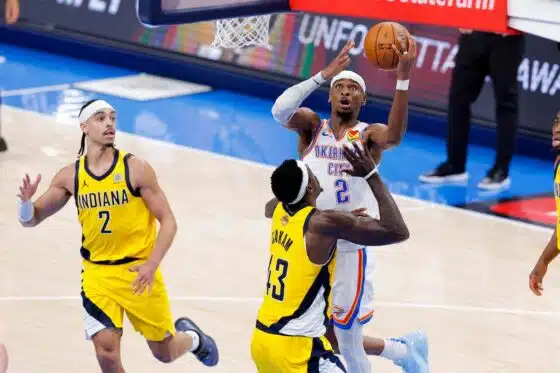
The Oklahoma City Thunder and Indiana Pacers shook a Mentos-filled Coca Cola bottle for 42 minutes, and at last, in the final six, it exploded all over Paycom Center to give Indiana a 1-0 series lead in the NBA Finals.
I’ll break down some of what we saw in that weird, rollicking Game 1, and the battlegrounds it laid out for the rest of the series, but we have to start at the end. We have to start with the how; it is impossible to understand how the Pacers won that game without accounting for their incredible self-belief, their resiliency, often such clichés it becomes hard to write about them without sounding cliché.
And yes, the Pacers also stole Game 1 due to to plenty of cricks in Oklahoma City’s offense, as well as a 46.2 percent performance from deep. But Obi Toppin, shooting in the mid-30s from deep on both the season and in his career, shot 5-of-8 from deep, making some huge ones in the second half. Blame Oklahoma City for leaving him open too often, blame the shooting variance gods for gently guiding the ball into the net, but first, watch his makes and feel the energy come through the screen.
Toppin believes they’re going in. His teammates passing him the ball or watching from the bench believe they’re going in; so do his coaches, relying on him after an individually disastrous start to the game. When Toppin flicks the wrist, you too believe — or, perhaps, know — that it’s going in. If you don’t, you haven’t watched enough of the Pacers.
Oklahoma City’s Underwhelming Shot Profile
Entering the Finals, the team that committed fewer turnovers was 53-20 in this year’s postseason. Indiana handed Oklahoma City 25 turnovers in Game 1, a record-setting 19 of which came in the first half. The Thunder did not just win the possession battle, but by attempting 16 more field-goals and three more free throws than their guests, they dominated it. And lost. What?
The quickest splash of water we can throw on this mathematical fire is shot quality. Despite the chasm in turnovers, Indiana managed to get up 39 3-pointers. Meanwhile, the Thunder took just 30 threes and a whopping 33 midrange shots, per Cleaning the Glass.
Credit to Indiana for forcing them into the least fruitful — even if you’re Shai Gilgeous-Alexander and Jalen Williams — part of the floor. Whether with extra help or in standard pick-and-roll coverage (particularly against Williams), they would veer-switch to induce these shots. In the first clip, Gilgeous-Alexander still gets what he wants and just misses, and in the latter two clips, Indiana’s bigs turn drop coverage into decent contests on Williams’ 18-footers:
The Thunder would probably tell you a bigger problem than taking 33 middies was making only eight and getting fouled on two, which is fair. But throughout the contest, it became increasingly clear Oklahoma City was playing into Indiana’s well-laid trap.
After swapping Isaiah Hartenstein for Cason Wallace in the starting five, head coach Mark Daigneault’s team played single-big lineups the whole night; Hartenstein and Chet Holmgren did not share the court once, and Jaylin Williams was glued to the pine. A defensive-minded principle to keep up with the pace and many actions of Indiana’s half-court offense? Perhaps, but an added side effect should have been fewer congested driving lanes for Oklahoma City’s perimeter players.
That was not the case, as the Thunder frequently utilized one or both dunker spots in their off-ball spacing. It made little sense in the moment; Gilgeous-Alexander and Williams are much better at making kick-outs than interior passes, and it allowed Indiana to bring help from the block instead of digging off the wings:
Nothing under the hood explaining these results is surprising. Oklahoma City shot 55.6 percent (13th percentile) at the rim? Well, help was always there. The Thunder only took 30 threes? Well, there were no one-pass-away threes available. Again, Indiana didn’t need to sit in the gaps with backline help always ready.
Shai, Turned All The Way Up
Now, a small reason the Pacers didn’t need to help so heavily in the gaps was the individual efforts of Andrew Nembahad on Gilgeous-Alexander and Aaron Nesmith on Williams. These two were hounded all night long, and though the MVP put up 38 points, he needed 30 shots and eight free throws to do it.
Daigneault shouldn’t be overly pleased with those numbers. Even before Indiana’s comeback at the end of the fourth, we saw Oklahoma City’s offense at its most stagnant, and the team did little to ease Gilgeous-Alexander into more comfortable situations than an isolation from 35 feet out. The only button the Thunder really pushed — one they wore out — was to bring Tyrese Haliburton into the screening action.
Haliburton hedged every single one of these screens, and while Nembhard was fantastic in recovery, Oklahoma City left some food on the table. Gilgeous-Alexander hit this pass just once:
SGA could have hit this pass much more than once tonight: pic.twitter.com/24rDntOtVJ
— Lucas Kaplan (@LucasKaplan_) June 6, 2025
He also attempted it just once.
At this point in its incredible season, Oklahoma City’s identity is set. It plays just about every possession through Gilgeous-Alexander, whose identity is also set. As I’ve written here before, its half-court offense as monotonous as possible for such a historically great team. It can still make life easier on Gilgeous-Alexander, who can also make it easier on himself.
Will there be more five-out spacing moving forward? If there is, will the Thunder just bite the bullet and play double-big lineups to juice the offensive glass? Will Gilgeous-Alexander look to dish the rock, even if he’s not throwing real high-level passes? Will they pair Williams with Hartenstein, a more frequent Gortat Screener than Holmgren, which helps generate rim attempts?
these Gortat screens from iHart really help Dub get all the way to the rim. Nice pairing: pic.twitter.com/vmEuQcaly1
— Lucas Kaplan (@LucasKaplan_) June 6, 2025
Is Indiana Destined To Lose The Turnover Battle?
Though their transition defense was admirable in Game 1, the Pacers will lose this series, and swiftly, if they turn it over more than 20 times a night. Much less 19 times in one half.
A few of their early turnovers were inevitable; adjusting from the New York Knicks’ defense to Oklahoma City’s induces whiplash for which you can’t prepare. Others were silly no matter the opponent. But many came from trying to pass the ball from the perimeter into the paint, a skill Indiana excels at and Oklahoma City rips to shreds.
The Thunder guards fly around post-ups to deny entry passes. Every time a driver tries to hit a pocket pass or a dump-off, eight hands suddenly form a maze for the ball to get through, it’s truly a sight to see. I was ready to scoff at Indiana’s hubris in thinking it could just power through, rather than avoid, Oklahoma City’s defense. And yet, while the turnovers slowed in the second half, the Pacers’ passing didn’t get less aggressive.
The first two clips feature turnovers on a Myles Turner short roll and an attempted post of a mismatch, two staples of their offense. In the latter two clips, it’s buckets on, well, you guessed it:
Indiana will likely turn the ball over less often in the coming games — it’d be hard to turn it over more. But will that come at the expense of its aggressive movement, flying up the court and attacking the first mismatch it sees fit? After the second half of Game 1, that’s tough to answer.
Controlled Pace(rs)
No matter what you ascribe the Pacers’ turnovers to, they got sped up in the first half. It didn’t mean they were playing too fast — they always do that — but rather, they weren’t calm and in control of their offense.
That changed in the second half, and not just because of tighter passing; they were able to initiate possessions with the off-ball movement necessary to shift a defense. The timing was there. Curiously, said off-ball actions were aligned with whoever was handling the ball.
I say curiously because, when watching these clips, Oklahoma City’s lack of ball pressure stands out. Indiana hits all its staples in this mini-compilation: a pitch-ahead into a handoff springs Nembhard downhill, there’s a pindown for Bennedict Mathurin to essentially start a pick-and-roll, a flare screen to ease Haliburton into an action. But the initial ball-handler, in all these clips, has free reign to dribble around and make the pass that gets it going:
Is this… is this Indiana wearing Oklahoma City out? Will the Thunder not have the energy to pressure the ball by the late second half of these games? Or did the Pacers just grow comfortable setting up their offense after halftime?
Other Takeaways
- Haliburton, everybody’s favorite pass-first point-guard, will have to be a bit more aggressive hunting pull-up 3-pointers and even midrange jumpers going forward. Eschewing an open shot, especially as a good shooter, to drive into the teeth of the Thunder defense is always a risk, especially if it only leads to Mathurin or Toppin making a decision amidst the chaos.
- Seriously, Nembhard navigating all these guard-to-guard screens or flat screens Oklahoma City sets deserves it own section.
- Daigneault trying to farm some robust player-development minutes for Ajay Mitchell (good rookie) in Game 1 of the NBA Finals was wild. Have to respect it.
- Out of the 30 Oklahoma City threes, 13 were taken by Dort, Holmgren and Alex Caruso. By design, very few of those were heavily contested.
- Holmgren scored six points and played less than half the game. Yikes. And yet, the Thunder posted a 92 defensive rating with him and a 127.5 defensive rating without him. His offense in the 2025 NBA Playoffs, particularly after missing such a huge chunk of the regular season, was always going to be up and down. How does Daigneault weigh his defensive impact going forward, if he even determines those stats are indicative of Holmgren’s impact?
Man, this series is going to be awesome. It already is. Game 2 is on Sunday night at 8:00 p.m. EST, and I have no plans to miss it.
